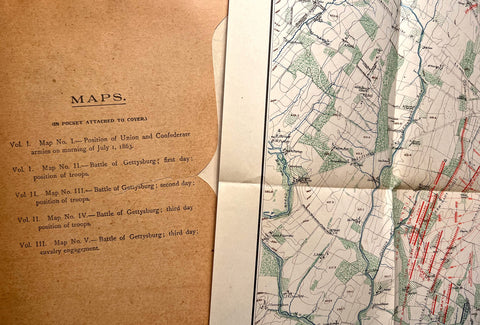
A Peek Inside the Library of Dana B. Shoaf, Civil War Times Editor
I still prefer to crack a book open than to click a mouse when it comes to research. Over the years, I’ve been fortunate to build up a small reference library that I constantly use when working on the magazine.
The three-volume series
is officially titled ‘The New York Monuments Commission for the Battlefields
of Gettysburg and Chattanooga. Final Report of the Battlefield of Gettysburg.’
I’ve been looking for a set of the three-volume New York Monuments Commission’s Final Report of the Battlefield of Gettysburg , and I finally found an affordable one in decent shape. The series was published in 1900 by J.B. Lyon Company of Albany, N.Y. The state of New York contributed more soldiers to the fight than any other in the Union, and therefore has the most monuments on the field, 87.
Volume One kicks off the series with a history of the battle, including data tables on daily itineraries, regimental rosters, casualties throughout the campaign, and a chapter on the 1893 “New York Day” when the state monument was dedicated in the National Cemetery.
The heart of the series, and its main value, are the chapters, organized chronologically by unit number, that contain photos of each unit’s monument, the inscriptions found on the monuments, and transcriptions of the monument dedication speeches. All should be viewed with some skepticism, as an old soldier’s memories could be cloudy. But they still provide detail and a sense of how the aging vets viewed their service.
With glossy photographs
and five detailed maps of the battlefield, it is obvious the Empire State
spent some coin on the set.
My set was once the property of Willard Devendorf of the 1st New York Light Artillery, as he wrote his name and unit inside the front cover of Volume Two. That made me curious about the New Yorker’s Gettysburg participation. To my surprise, I learned that, even though his 5th Corps battery was posted on the northern extension of Little Round Top on July 2, it didn’t fire a shot. Devendorf and his comrades never had a clear field of fire due to terrain, and friendly troops were almost always in their front. On July 3, they were sent farther south, and didn’t get a crack at Pickett’s Charge. I think they were the only 5th Corps battery that was not engaged.
That story is just one example of how research books lead to further research and more knowledge.
